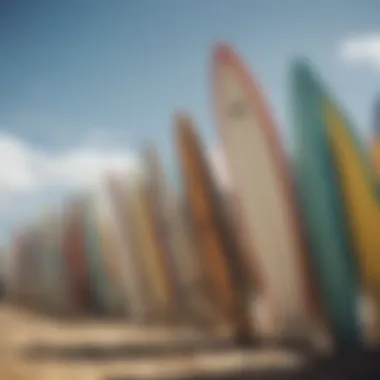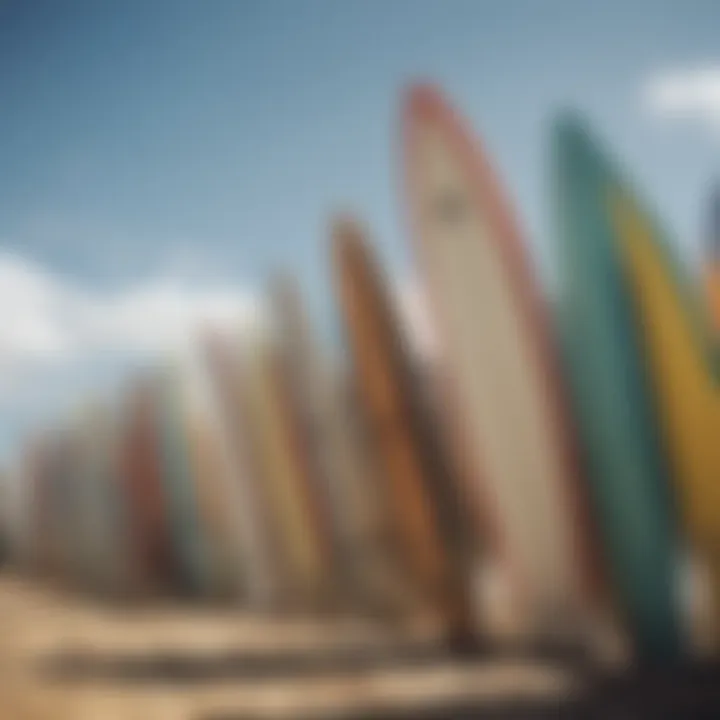Why a Surfboard Nose Protector Matters for Surfers


Intro
When it comes to the art of surfing, enthusiasts often get caught up in the glitz of boards, brands, and slick tricks. Yet, one subtle accessory can make a world of difference—the surfboard nose protector. These nifty additions, though often overlooked, play a crucial role in safeguarding your beloved board from the rigors of the ocean and the choppy nature of the surf.
Indeed, knowing how to ride the waves is just one part of the equation; protecting your equipment is equally important. A nose protector shields the delicate tip of the surfboard from nicks, scratches, and potential damage from collisions with rocks, reefs, or even fellow surfers. After all, a banged-up nose can ruin both your ride and your spirits.
This article aims to peel back the layers of why a nose protector is not just a nice-to-have but rather an essential piece of gear for any serious surfer—whether you’re just starting out or you’re a seasoned wave rider with ample experience under your belt.
Foreword to Surfboard Nose Protectors
Understanding the significance of surfboard nose protectors goes beyond mere accessories; it highlights an essential aspect of surfing that often gets brushed off. These protectors play a pivotal role in safeguarding one of the most critical parts of the surfboard—the nose. Chipping, dings, or any sort of wear on this area can lead to a chain reaction of damages that affect the overall performance of the board.
Think of it this way: a surfboard without a nose protector is like a car without insurance. The absence of protective gear might seem inconsequential at first. However, one rough wave or an accidental knock against a hard surface can turn a seemingly minor issue into a costly repair.
When it comes to surfing, protecting your investment is key. Not only do nose protectors shield against physical damage, but they also help maintain the board’s integrity and aesthetics, prolonging its lifespan and enhancing its resale value. Moreover, beyond mere functionality, they can add a touch of personal style that speaks to a surfer's individuality.
Definition and Purpose
A surfboard nose protector, as the name suggests, is a shield designed to protect the nose or tip of a surfboard from impacts and scratches. These protectors come in various forms, including adhesive films, removable pads, and custom-fitted designs. Each type offers varying degrees of protection, depending on the surfing conditions and the individual’s style.
The primary purpose of these devices is to absorb impacts that might otherwise lead to significant damage. For surfers who frequently ride in rocky conditions or those who are prone to landings that risk dings, a nose protector becomes more of a necessity than just an accessory. The impact resistance can save considerable money on repairs and keep the board performing at its best.
Historical Evolution
The journey of nose protectors is as rich as the surfing culture itself. In the early days of surfing, boards were considered invincible, crafted from solid forms of wood or fiberglass. As the sport evolved and designs became more intricate—lighter, faster, and more agile—the weak spots, especially the nose, began to reveal themselves.
Historically, surfers would often resort to DIY solutions, using everything from old bike tires to foam pads haphazardly taped to boards. With the advent of modern materials and a growing market for surf accessories, specialized nose protectors emerged, marking a significant evolution in design and functionality.
The introduction of polyurethane and various plastics in manufacturing changed the game, allowing for tailored designs that not only provided better protection but also enhanced the visual appeal of the boards. Today, a combination of technology and creativity continually pushes the boundaries of what these nose protectors can achieve.
Types of Nose Protectors
When navigating the waves, a surfboard can be a surfer's best friend or worst enemy depending on how it's cared for. One essential component often overlooked is the nose protector. Understanding the different types of protectors available can help ensure that your surfboard remains in mint condition while you carve through the water. Each type comes with its advantages and considerations, making it vital for surfers to choose wisely based on their specific needs and surfing style.
Adhesive Protectors
Adhesive nose protectors, as the name suggests, attach directly to the surfboard's nose using strong adhesive. The simplicity of application is one of their most appealing features. As long as the surface is clean and dry, these protectors can be successfully affixed with minimal effort.
- Durable and Efficient: Made of materials like polyurethane or silicon, adhesive protectors can withstand the rigors of surfboard use while protecting against dings and scratches.
- Minimalistic Look: Many surfers appreciate how low-profile these can be. With numerous styles and colors that blend seamlessly into the surfboard's design, they can maintain the aesthetic without compromising performance.
However, it's important to keep in mind that over time, the adhesive may weaken, particularly if exposed to excessive moisture and sunlight. Regular checks can help prevent any issues, but generally, they provide reliable protection for the average surfer.
Removable Options
For surfers who frequently switch boards or prefer flexibility, removable nose protectors can be particularly appealing. These options can be easily attached and detached as necessary, allowing for quick transitions between different surfboards or conditions.
- Versatility: Ideal for those who can’t commit to one board or style, removable options cater to a variety of needs without being permanent.
- Easy to Clean and Maintain: Since these protectors don’t adhere permanently, they can be taken off, allowing surfers to clean both the board and the product itself without a hassle.
It's worth noting though, that while they are convenient, the bond to the surfboard may not be as strong as that of adhesive options, especially in choppy waters or if not secured properly.
Custom-Fitted Designs
For those looking for the ultimate protection tailored to their surfboard, custom-fitted designs provide a perfect solution. These are crafted specifically to match the shape and contours of the surfboard, ensuring optimal coverage.
- Perfect Fit: Since these designs are made for a specific board, they not only protect against damage but can enhance the board's overall performance. Surfers often find that custom designs add an extra layer of confidence as they paddle out.
- Professional Appeal: Custom protectors tend to resonate well with serious surfers or professionals wanting to maintain their gear and performance at the best level.
However, if someone decides to switch boards, the custom fit may not be suitable for other designs, which is a downside to consider. Overall, they offer superior protection tailored to individual surfer needs.
The choice of nose protector ultimately hinges on a surfer's unique requirements, riding style, and priorities. Understanding these different types unlocks the potential to keep one’s board safe and sound.
By selecting the appropriate type of nose protector, surfers can enhance their experiences on the waves, safeguard their gear, and maintain peak performance while enjoying the sport they love.
Benefits of Using Nose Protectors
When it comes to surfing, many think only of the board shape or the wax condition, yet an often-overlooked feature is the nose protector. This tiny accessory plays a significant role. By diving into the benefits of using nose protectors, we can highlight their importance not just for the board but for the surfer’s experience as a whole.
Protection Against Dings and Dents
One of the most compelling reasons to use a nose protector is the protection it offers against dings and dents. Surfboards are often exposed to harsh conditions, knocks, and rough treatment while out in the waves or when being transported. A simple bump against a rocky outcrop or a collision with another board can leave unsightly marks or potentially damage the board’s integrity.
- Using a nose protector can absorb the shock from these impacts, helping to maintain the board's structure and prolonging its life. Whether it's made from durable foam or rubberized materials, a well-crafted nose protector acts like a shock absorber, preventing serious damage before it starts.
Enhanced Resale Value


Surfers are a savvy bunch, and many understand the importance of maintaining their gear for resale down the line. A board that is free of dings and scrapes is far more marketable than one that bears the scars of wear and tear. For those considering selling their boards, a nose protector can mean the difference between a good and a great price.
"A clean, well-maintained board can fetch a decent price on the used market—every little dent avoided counts!"
With snug-fitting nose protectors, surfers can keep their boards looking fresh, which appeals to potential buyers. Plus, it indicates that the surfer took proper care of the gear, adding to the overall value and trustworthiness during the sale.
Improved Aesthetics
Looks matter in the surf culture, and an appealing board can enhance a surfer's personal style. Nose protectors today come in various colors and designs, allowing surfers to express their individuality. This means a protective accessory can also be a fashion statement.
When a board has a sleek nose protector, it not only makes it more engaging to look at but can even elevate one's confidence in the water. The psychological aspect shouldn’t be underestimated. A well-groomed surfboard, complete with a nose protector, can make a surfer feel more positive about their presence in the lineup.
In summary, the benefits of using nose protectors cannot be overstated. From the practicalities of protection and resale value to the aesthetic appeal, these little add-ons play a major role in the longevity and performance of surfboards. As surfers continue to hone their skills and engage with their boards, nose protectors remain a smart choice for safeguarding their best assets.
Materials Used in Nose Protectors
The choice of material in surfboard nose protectors plays a critical role in their performance and longevity. By understanding the various materials available, surfers can make informed decisions about what best suits their individual needs. This section will analyze the importance of different compositions, emphasizing their benefits and addressing the considerations accompanying each type.
Foam and Rubber Compositions
Foam and rubber compositions are popular for surfboard nose protectors, primarily due to their shock-absorbing characteristics. These materials are light yet durable, providing an essential layer of cushioning. They're designed to help withstand impact during crashes and the inevitable bumps that occur while surfing or transporting a board.
Unlike harder materials, foam and rubber can flex and conform to the surfboard's shape, resulting in a snug and secure fit. Additionally, the soft surface minimizes the chance of damaging the board itself, which is vital for preserving resale value.
- Flexibility: Foam’s elasticity allows for easy applications, meaning surfers can quickly install or remove the protector without damaging the surfboard.
- Customizable Thickness: This material often comes in different thicknesses, allowing users to pick the one that fits their style and preferences.
Ultimately, foam and rubber protectors offer a perfect balance of protection and adaptability, making them a top pick for many surfers.
Polycarbonate and Hard Plastics
For those seeking sturdiness, polycarbonate and hard plastics present a compelling option. These materials dominate the market in terms of strength and resilience against physical stress. They’re crafted to endure harsher conditions, making them ideal for aggressive surfing styles where impacts are more frequent.
The rigid nature of polycarbonate helps to maintain the integrity of the surfboard, offering unmatched protection against dings and cracks. Plus, their smooth finish enhances glide through water, potentially improving paddle efficiency.
Here are some defining factors:
- Durability: Robust against impacts, these materials typically outlast their foam and rubber counterparts in demanding situations.
- Water Resistant: Unlike softer materials, hard plastics are less susceptible to water damage, ensuring longevity in wet conditions.
In summary, polycarbonate and hard plastics deliver a reliable protective solution for surfers who frequently navigate challenging conditions.
Biodegradable Options
In today's eco-conscious world, biodegradable options are becoming increasingly important. Materials like plant-based composites and recycled plastics are gaining traction for those who prioritize sustainability without sacrificing performance.
These innovative materials not only reduce plastic waste but also maintain a level of sturdiness that meets the needs of most surfers.
- Environmental Impact: By choosing biodegradable options, surfers contribute to reducing the overall carbon footprint, aligning their passion with care for ocean health.
- Shorter Decomposition Time: Unlike traditional plastics that linger in landfills for decades, biodegradable options decompose more quickly, reducing long-term environmental harm.
("Investing in biodegradable surfboard nose protectors is not just a choice for today but a commitment to preserving the ocean for future generations.")
Selecting the Right Nose Protector
Choosing the right nose protector is crucial for surfers. It's not just about aesthetics; it can significantly impact the durability and performance of your board. A fitting nose protector shields your board from harsh impacts, dings, and the inevitable mishaps that occur in the water. It's an investment in your surfing experience, ensuring that the board stays in shape longer, ultimately enhancing your time on the waves.
Considerations Based on Surfing Style
Your surfing style plays a big role in selecting the right nose protector. For instance, aggressive surfers often tackle larger waves, leading to a higher chance of collisions. Hence, a thicker, more robust protector might be needed to absorb impact effectively. Conversely, casual surfers who enjoy riding smaller waves might opt for lighter, less obtrusive options. It's like choosing the right tool for the job; ensuring you have what fits your methods means you'll surf with less worry.
"The right nose protector is as important as the board itself, helping to keep it intact and ready to conquer the next big wave."
Think about your surfing frequency too. If you’re constantly in the water, a durable protector made from high-performance materials would be wise. If you’re more of a weekend wave rider, a simple adhesive protector might suffice. Reflecting on your habits and style helps align your choice with actual needs.
Environmental Factors
When selecting a nose protector, it’s crucial to consider the environment where you typically surf. Factors such as water temperature, salinity, and exposure to sun can impact the performance and lifespan of a protector. For example, if you often surf in warm, sunny climates, UV exposure can degrade certain materials quickly.
Additionally, if you surf in saltwater conditions, you might require a protector that can withstand corrosion. Some protectors are more resilient to such elements, ensuring they remain effective despite challenging environmental conditions. In this case, investing in high-quality, resistant materials goes a long way.
Compatibility with Surfboard Shape
Every surfboard has its unique shape and design, so the nose protector must complement that specific style. For example, a shortboard typically has a narrower nose than a longboard. Selecting a protector that matches your board’s dimensions ensures maximum coverage without hindering performance. Misfitting protectors can create drag or even alter how the board moves through the water.
Before purchasing a nose protector, consider checking the manufacturer’s recommendations. Many brands offer specific sizes and designs tailored to various board shapes, which helps ensure that you're getting a protector that works harmoniously with your gear. Taking this step avoids the pitfalls of trial and error, saving time and possibly money in the long run.


In summary, selecting the right nose protector involves deliberating on personal surfing style, environmental conditions, and the board's shape. Each of these elements contributes harmoniously to an optimized surfing experience, ensuring that the board remains not just intact, but also performance-ready as you glide atop the waves.
Maintenance and Care for Nose Protectors
When it comes to your surfboard, protecting the nose is just like putting a helmet on before a bike ride—it’s essential. All too often, surfers overlook the significance of regular maintenance and care for nose protectors. Investing time in their upkeep not only prolongs the life of the protector itself but also helps maintain the integrity of the board. Whether you’re a weekend warrior or a full-time wave chaser, understanding how to care for your nose protector can save headaches down the road. It’s about better performance and ensuring safety on the water.
Cleaning Techniques
Keeping your nose protector clean is just as important as having the right one in the first place. Dust, salt, sand, and grime can build up, potentially creating a gritty surface that can wear out the protector faster than a pair of flip-flops at the beach. Here are some practical cleaning tips to consider:
- Mild Soap and Water: Always start with a basic soap solution. A gentle dish soap mixed with warm water does wonders. Use a soft cloth or sponge to wipe down the protector, rinsing thoroughly afterward.
- Avoid Abrasive Cleaners: Using harsh chemicals or scrub pads can damage the surface of the protector, leading to reduced effectiveness over time. Stick to simple solutions to keep it shiny and protective.
- Drying Techniques: After cleaning, allow the protector to air dry completely. Direct sunlight can warp or degrade some materials, so be mindful to keep it in a shaded area until it’s ready for use.
Regular Inspection for Wear and Tear
Just like a good mechanic checks your car, regularly inspecting your nose protector can save you from unforeseen mishaps. Frequent checks are key for identifying any wear or damage, which might not be visible at first glance. Here’s how to do it effectively:
- Visual Checks: Look for cracks, tears, or discolorations on the protector. Minor damage can often be patched early to prevent it from worsening.
- Tactile Feelings: Run your fingers along the nose protector to feel for any rough spots or bumps that shouldn't be there. If it feels different than when it was new, it may need replacing.
- Scheduled Inspections: Make it a routine, perhaps at the start or end of each surf season. If you surf regularly, inspecting every few weeks can really help catch issues before they escalate.
"A little maintenance goes a long way. If you treat your gear well, it will treat you well in return."
Ultimately, taking the time to clean and inspect your nose protector helps ensure your surfing experience remains smooth and enjoyable. Remember, a little effort in maintenance today can save you from costly repairs or replacements later on.
The Impact of Nose Protectors on Surf Performance
Surfing is not just a sport; it’s a dance with the waves where every move counts. When it comes to your performance on the board, the subtleties can make a world of difference. Nose protectors, often seen as mere accessories, play a bigger role in enhancing your surfing experience than one might initially realize. Understanding how these simple, yet effective items influence performance can elevate your time on the water.
Influence on Balance and Control
One of the key aspects in surfing is balance. A well-placed nose protector can aid in maintaining balance, especially during those challenging maneuvers. Picture this: you’re catching a wave, and the perfect moment strikes as you attempt a sharp turn or a bottom drop. The friction and stability offered by a nose protector can keep your board from slipping, thereby assisting you in maintaining an upright position.
This component becomes even more critical for surfers who favor a particular style, such as nose riding, where control is paramount. Think of the nose protector as the unsung hero that keeps you grounded. The materials used, whether rubber or foam, also contribute to this function by providing a slight grip that enhances balance. Therefore, it’s not just about protecting that delicate tip; it’s about empowerment—providing you with the confidence to push your limits.
Effects on Paddle Efficiency
Another notable impact of nose protectors is paddle efficiency. For many surfers, the initial moments before catching a wave can determine the success of their ride. A streamlined nose protector can reduce drag, allowing for smoother paddle strokes. Instead of spending valuable energy fighting against water resistance, surfers can glide through the water more effortlessly. Less drag means more speed, which can be crucial, especially when you’re trying to get ahead of fellow surfers vying for the same wave.
Moreover, the right nose protector suits the surfboard shape, aligning with your paddling technique. This symbiosis not only enhances your paddle performance but also contributes to the overall energy conservation while you're out on the water. Efficiency in paddling means you're catching more waves, maximizing your surf session, and, frankly, enjoying every moment more.
"It’s these small adjustments that can turn a good day of surfing into a great one. It ain’t just a nose protector; it’s a game-changer."
In summary, nose protectors wield significant influence over balance and control as well as paddle efficiency. These factors are essential for any surfer looking to elevate their skills in the ocean. The implications go beyond mere aesthetics; they touch on the core of what it means to surf effectively and enjoyably.
Comparative Analysis of Popular Brands
In the realm of surfboard nose protectors, understanding the offerings from different brands can be a game-changer. The notion of comparative analysis allows surfers to make informed choices, ensuring that they pick the protector that best suits their needs. Not only does it shed light on the materials used and performance aspects, but it also highlights unique features that set each brand apart. Such an analysis goes beyond mere specifications; it helps to weave a narrative around brand trust, quality assurance, and user testimonials. By analyzing different options, surfers can find a nose protector that resonates with their style and requirements, ultimately enhancing their surfing experience.
Brand A Overview
Brand A has carved a niche for itself in the surfboard accessories market, particularly with its nose protector line. The standout feature in Brand A's products is their proprietary foam technology. This innovative foam is designed to absorb impact effectively, giving surfers confidence while riding the waves. The brand also places a strong emphasis on aesthetics, offering several colors and designs that can match various board aesthetics.
Moreover, surfers have noted the ease of application with Brand A's adhesive protectors. These products tend to stick well and hold up remarkably over time, even when exposed to sun and saltwater. Additionally, customer feedback aligns with the overall sentiment that Brand A truly understands the needs of surfers by providing quality products that blend functionality with a touch of style.
Brand B Overview
Then we have Brand B, which distinguishes itself through its eco-friendly approach. Committed to sustainability, the brand utilizes biodegradable materials that appeal to environmentally conscious surfers. This choice does not compromise on quality; their nose protectors are rated highly for durability and efficiency in guarding against dings and scratches.
A notable aspect of Brand B's offerings is their removable design feature, making it convenient for surfers who like to switch out protectors based on their surf conditions or preferences. According to testimonials, this flexibility has gained a loyal following among diverse surfers, particularly those traveling to different beach locations.
Brand Overview
Brand C has become synonymous with custom-fitted nose protectors. They offer an array of sizing options tailored to fit various surfboard shapes, thus ensuring maximum protection. This bespoke option allows surfers to have a peace of mind that their board is shielded adequately, regardless of how aggressively they ride.
The material used by Brand C is of premium quality, often quoted as a critical factor in their widespread acclaim. Surfers have reported that the protectors do not impede performance and actually enhance control during rides. Furthermore, their branding also leans heavily on user experience, with community involvement in product testing and feedback, making every iteration more aligned with the real needs of surfers.
With these evaluations in hand, it's clear why a detailed comparison among the leading brands of nose protectors can guide surfers in selecting products that truly align with their surfing aspirations.
Consumer Feedback and Trends
Understanding consumer feedback and the trends within the surfboard nose protector market is crucial for a few reasons. Firstly, this insight helps surfboard manufacturers align their offerings with what actual users deem valuable. In a sport laden with personal preference and unique needs, the knowledge about what surfers genuinely favor can dictate future designs and innovations.
Additionally, tracking trends reflects larger shifts in surfing culture and environmental awareness, potentially guiding brands towards sustainability. In a world that’s becoming increasingly eco-conscious, understanding how this impacts consumer decisions can inform future developments. It’s one thing to ride a wave, but knowing how to efficiently navigate the marketplace is vital for anyone involved in selling gear or enhancing surfing experiences.
Surfer Preferences


When it comes down to it, surfer preferences are as varied as the waves themselves. Some surfers seek maximum protection, while others might prioritize aesthetics or lightness of their gear. Here are a few elements that highlight overriding preferences in nose protectors:
- Durability: Many surfers lean toward nose protectors that can withstand the wear and tear of rigorous use. Being tossed about by waves can quickly compromise equipment.
- Ease of application: Convenience matters. Nobody wants to spend an entire morning fumbling with protector installation instead of catching waves. Quick adhesive options are often favored.
- Custom feel: Some surfers demand custom-fitted designs that truly blend with their board's shape. They often believe that a perfect fit enhances overall performance and comfort.
- Eco-friendly materials: An emerging tendency is towards eco-conscious products. Many surfers state a preference for materials that won’t endanger ocean health, leading to both ethical considerations and market competitiveness.
Regardless of their location or skill level, surfers consistently provide feedback that pushes manufacturers to adapt and innovate.
Market Trends
As the surfing community evolves, so do its products. Keeping an eye on market trends can provide a glimpse into what’s on the horizon:
- Sustainable Products: Increasing awareness of the environmental impact has prompted brands to explore biodegradable options or those sourced from recycled materials. Products that make their mark on both surf performance and ocean protection are gaining traction.
- Integration of Technology: Some innovations are blending technology with performance. For instance, some new models have electronic components, like sensors for tracking damage or wear over time. These advances might seem futuristic but are taking root gradually.
- Customization and Personalization: The demand for personalized equipment is soaring. Surfers enjoy expressing their style, and nose protectors are no exception. Custom graphics or fit adjustments are quickly becoming a staple in the selection process.
- Online Community Influence: Social media platforms like Reddit and Instagram allow locals to share their experiences and preferences, affecting how products are marketed. This community feedback loop enables brands to address what surfers actually want, creating a dynamic and responsive marketplace.
In sum, by keeping a pulse on consumer preferences and trends, surfboard manufacturers can better satisfy the needs of their customers. This cyclical relationship between feedback and product evolution paves the way for not only enhanced surfing experiences but also for a healthier ocean environment.
Environmental Considerations
When we discuss surfboard nose protectors, it's essential to shed light on their environmental implications. Surfing, being closely linked to the ocean, often brings a unique set of challenges related to sustainability and conservation. As the global awareness around climate change and ecological impact grows, the materials and production methods employed in crafting nose protectors become increasingly significant.
Sustainability in Manufacturing
Choosing sustainable materials and manufacturing techniques can make a world of difference. Many brands are shifting toward using recycled or biodegradable materials for their nose protectors, which not only helps reduce waste but also maintains performance.
- Recycled Materials: Such options are coming into play, allowing manufacturers to make nose protectors without pulling more resources from the earth. For instance, using recycled EVA foam not only minimizes landfill waste but also keeps your surfboard well-protected.
- Eco-Friendly Adhesives: The glues and adhesives used to attach these protectors can also take a toll on the environment. Companies are now looking into water-based and non-toxic alternatives that don’t harm the ocean ecosystem.
This attention to sustainable choices doesn’t just help the planet; it appeals to consumers who are more eco-conscious than ever before. They are not just buying a product—they are opting for a lifestyle change. Investing in these innovative materials can reduce the carbon footprint associated with surfing gear. Whether you're a seasoned surfer or just establishing your beachside routines, being part of this movement can fundamentally alter our environmental impact.
Impact on Ocean Health
The health of the oceans is paramount, not just for surfers but for all life forms on our planet. When nose protectors are made with care for the environment, they contribute positively to ocean health. For example, traditional plastic protectors can break down into microplastics, washing back into the ocean and impacting marine life. This happens because the harsh saltwater, waves, and sunbreak down the materials over time.
By opting for biodegradable options:
- You help minimize the risk of pollution from damaged or discarded protectors.
- When protectors deteriorate, they do so without leaving harmful residues that threaten marine ecosystems.
- This is crucial in preserving the delicate balance of oceanic flora and fauna.
It’s become clear that there is a more significant responsibility that comes with surfing the waves. Protecting your board doesn’t just mean investing in better gear, but also investing in the larger effort to keep oceans clean and sustainable for future generations.
"Sustainable practices in surfing equipment manufacturing reflect a commitment not only to performance but to preserving the very environment surfers cherish."
The next time you choose a nose protector, consider not only how it safeguards your gear but also how it safeguards our oceans and ecosystems. Surfing is a way of life that can promote health and vitality not just for surfers, but for the world we surf in.
Future Innovations in Nose Protector Technology
As surfing continues to evolve, so too does the technology behind surfboard accessories, including nose protectors. This is not just about keeping your board pristine anymore; advancements in materials and design are paving the way for better performance, safety, and environmental sustainability. The future of nose protectors will likely include features that respond not only to the rigors of the surf but also to the changing preferences of surfers who demand more from their gear.
Advancements in Materials
One of the most exciting areas of development in nose protector technology is material innovation. Traditional rubber and foam are still widely used, with each having its unique benefits. However, new high-tech materials like thermoplastic elastomers (TPE) and advanced composites provide enhanced durability and flexibility.
- Thermoplastic Elastomers: TPE is a game-changer. It's tough yet elastic, taking the punch from impacts while having enough give to avoid damaging the surfboard itself.
- Carbon Fiber Reinforcement: Another material making waves is carbon fiber. While it’s commonly associated with high-end surfboards, integrating it into nose protectors could significantly enhance resilience against dings.
- Eco-Friendly Options: As the surfing community becomes increasingly aware of environmental issues, biodegradable materials are gaining traction. Manufacturers are exploring bioresins that are less harmful to ocean life while maintaining high performance.
These advancements aren't merely add-ons; they represent an understanding of the need for sustainable practices in sports equipment, marrying performance with care for the environment.
Emerging Designs and Features
For those who think that a nose protector is straightforward, think again. The designs emerging now reflect a blend of functionality and surfer-centric features that enhance usability.
- Aerodynamic Shapes: New designs focus on aerodynamics, allowing surfers to experience less drag. Protectors are increasingly being shaped to flow with the natural lines of the board, providing not just protection but improved performance in water.
- Customizable Fit: Gone are the days of one-size-fits-all. Brands are working on nose protectors that can be custom-molded to fit specific board shapes. This means better protective coverage and a personalized touch to your gear.
- Integrated Technology: Imagine having sensors that could provide real-time data on board performance or detect impacts that could cause damage. This could revolutionize how surfers interact with their boards and enhance training regimens.
"The integration of smart technology into surf gear is not a pipe dream anymore; it’s right on the horizon."
The continual innovations in nose protector technology are shaping the future of surfing. By understanding these trends, surfers can make informed choices that protect their boards and ultimately enhance their surfing experience.
Finale
In this article, we have explored the often overlooked yet significant role that surfboard nose protectors play in enhancing the longevity and performance of surfboards. With the ability to shield delicate noses from unwanted dings and impacts, these protectors serve both a functional and aesthetic purpose. They allow surfers to ride with greater confidence, knowing that their gear is safeguarded against the unpredictable nature of the ocean.
Summary of Key Points
To summarize, a surfboard nose protector:
- Prevents Damage: It acts as a barrier against minor impacts that can lead to costly repairs or replacements.
- Preserves Value: A well-maintained board, thanks to a nose protector, retains its resale value better than one subject to damage.
- Enhances Performance: By maintaining the integrity of the board, it contributes positively to paddling efficiency and balance.
- Offers Versatility: Available in various materials and designs, there are options for every surfer's specific needs.
- Supports Sustainability: Many modern protectors are engineered with eco-friendly materials, helping to reduce the environmental footprint.
Final Thoughts on Necessity
Ultimately, the necessity of a nose protector transcends mere practicality; it reflects a surfer's commitment to their craft and gear. Investing in a quality surfboard nose protector not only prolongs the lifespan of the board but also enhances the overall surfing experience. Given the often harsh conditions surfers face, having this seemingly simple accessory can be the difference between a smooth session and a frustrating day.
Whether a seasoned professional or a weekend warrior, every surfer should give serious thought to equipping their board with a nose protector. Remember, protecting your investment is not just smart—it's essential for continuing to ride the waves safely and confidently.
"A good surfer respects their gear; the ocean is wild enough without adding board damage to the mix."
By prioritizing thoughtful selection and diligent maintenance of nose protectors, surfers can ensure that every ride is not only enjoyable but also sustainable in the long run.



